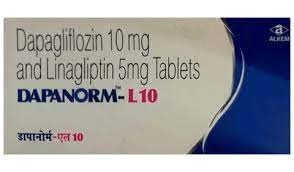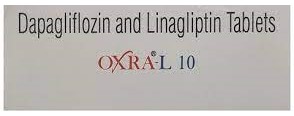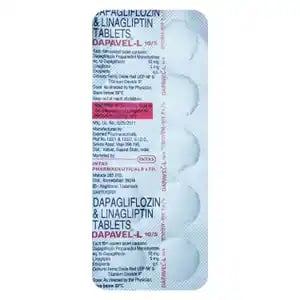Ondero D 10mg/5mg Tablet 10s DAPAGLIFLOZIN + LINAGLIPTIN
Ondero D 5mg/10mg Tablet 10s is a medication that combines Dapagliflozin and Linagliptin and is prescribed to manage blood sugar levels in adults diagnosed with Type 2 Diabetes.
Dapagliflozin prevents the kidneys from reabsorbing glucose, leading to increased sugar elimination through urine. Linagliptin works by blocking an enzyme that regulates hormones boosting insulin and lowering glucagon, thereby helping to control blood sugar levels.
Follow your doctor's prescribed dose and duration It can be taken with or without food, but consistency in the daily intake time is recommended for better results.
Possible side effects include vaginal yeast infections, inflammation of the throat and nasal passages (nasopharyngitis), and urinary tract infections.
Ondero D 5mg/10mg Tablet 10s may increase urine production, potentially causing dehydration. Ensure adequate fluid intake, particularly during situations that may lead to fluid loss like diarrhea, vomiting, or excessive sweating. Individuals with liver impairment might require dose adjustments.
If a dose is missed, take it when remembered However, if the next dose is approaching, skip the missed dose Avoid doubling the dose Consult your doctor for guidance on managing missed doses effectively.
Always adhere to your doctor's advice and promptly report any concerning symptoms or side effects while taking this medication.

Are the medicines in combination of Dapagliflozin and Linagliptin safe to take together?
While Dapagliflozin and Linagliptin are often used together, they do not have significant interactions with each other. However, when combined with other medications, they can increase the risk of hypoglycemia, especially with insulin or sulfonylureas. Monitoring involves regular blood sugar checks to ensure levels remain stable and adjusting doses of insulin or sulfonylureas if necessary. Healthcare providers may also monitor kidney function and electrolytes, especially if the patient is on diuretics, to prevent dehydration and electrolyte imbalances.

Are there harms and risks from taking combination of Dapagliflozin and Linagliptin?
Common side effects of Dapagliflozin include increased urination, urinary tract infections, and genital infections. Linagliptin may cause side effects such as stuffy or runny nose, sore throat, and cough. Both medications can lead to hypoglycemia, especially when used with insulin or sulfonylureas. Significant adverse effects include the risk of pancreatitis with Linagliptin and dehydration or ketoacidosis with Dapagliflozin. Patients should be aware of these potential side effects and report any severe or persistent symptoms to their healthcare provider.

Can I take combination of Dapagliflozin and Linagliptin if I am pregnant?
Dapagliflozin is not recommended during the second and third trimesters of pregnancy due to potential adverse effects on fetal kidney development. Linagliptin has not been shown to cause harm in animal studies, but there is limited data on its use in pregnant women. Both medications should be used during pregnancy only if the potential benefit justifies the potential risk to the fetus. Pregnant women should discuss their treatment options with their healthcare provider to ensure the safest approach to managing diabetes during pregnancy.

Can I take combination of Dapagliflozin and Linagliptin while breastfeeding?
The safety of Dapagliflozin and Linagliptin during lactation is not well established. Dapagliflozin is not recommended during breastfeeding due to the potential risk to the developing kidneys of the infant. Linagliptin's presence in human milk is unknown, but it is present in rat milk, suggesting potential exposure to the infant. Therefore, breastfeeding mothers should consult their healthcare provider to weigh the benefits and risks of continuing these medications while nursing, and alternative treatments may be considered.

Can I take combination of Dapagliflozin and Linagliptin with other prescription drugs?
Dapagliflozin may interact with diuretics, increasing the risk of dehydration and hypotension. Linagliptin can interact with strong inducers of CYP3A4 or P-gp, such as rifampin, which may reduce its effectiveness. Both medications can increase the risk of hypoglycemia when used with insulin or insulin secretagogues like sulfonylureas. Patients should inform their healthcare provider of all medications they are taking to manage potential interactions effectively and adjust dosages as necessary.

For how long is combination of Dapagliflozin and Linagliptin taken?
Dapagliflozin and Linagliptin are typically used as long-term treatments for managing type 2 diabetes. They are intended for continuous use to maintain blood sugar control, as diabetes is a chronic condition that requires ongoing management. Both medications are taken daily and are part of a comprehensive treatment plan that includes diet and exercise. The duration of use is generally indefinite, as long as the patient continues to benefit from the therapy and does not experience significant side effects.

How does combination of Dapagliflozin and Linagliptin work?
Dapagliflozin works by inhibiting the sodium-glucose co-transporter 2 (SGLT2) in the kidneys, which leads to increased excretion of glucose through urine, thereby lowering blood sugar levels. Linagliptin, on the other hand, inhibits the enzyme dipeptidyl peptidase-4 (DPP-4), which increases the levels of incretin hormones. These hormones enhance insulin secretion and decrease glucagon levels, improving blood sugar control. Both medications work together to provide a comprehensive approach to managing type 2 diabetes by targeting different mechanisms in the body.

How does one take combination of Dapagliflozin and Linagliptin?
Dapagliflozin and Linagliptin can be taken with or without food, making them convenient for daily use. It is important to take them at the same time each day to maintain consistent blood levels. Patients should follow their healthcare provider's dietary recommendations, which typically include a balanced diet to help manage diabetes. There are no specific food restrictions associated with these medications, but patients should avoid excessive alcohol consumption, as it can affect blood sugar levels and increase the risk of side effects.

How do I know if combination of Dapagliflozin and Linagliptin is working?
The benefit of Dapagliflozin and Linagliptin is primarily assessed through regular monitoring of blood sugar levels, including fasting plasma glucose (FPG) and hemoglobin A1c (HbA1c) tests. These tests help determine how well the medications are controlling blood sugar over time. Additionally, improvements in symptoms of diabetes, such as reduced thirst and urination, can indicate effectiveness. Both medications aim to lower HbA1c levels, with Dapagliflozin also contributing to weight loss and Linagliptin enhancing insulin secretion, providing a comprehensive approach to diabetes management.

How do I store combination of Dapagliflozin and Linagliptin?
Dapagliflozin and Linagliptin do not require refrigeration. They should be stored at room temperature, between 20°C to 25°C (68°F to 77°F), and kept away from excess heat and moisture. It is important to keep these medications in their original containers, tightly closed, and out of reach of children. Proper storage ensures the medications maintain their effectiveness and safety over time.

How effective is combination of Dapagliflozin and Linagliptin?
Clinical trials have demonstrated the effectiveness of Dapagliflozin and Linagliptin in managing type 2 diabetes. Dapagliflozin has been shown to significantly lower HbA1c levels, improve fasting plasma glucose, and reduce the risk of hospitalization for heart failure. Linagliptin effectively lowers HbA1c and improves post-prandial glucose levels by enhancing insulin secretion. Both medications have been studied in various combinations and as monotherapy, consistently showing improvements in glycemic control. Their complementary mechanisms of action provide a robust approach to diabetes management, supported by extensive clinical research.

How long does it take for combination of Dapagliflozin and Linagliptin to work?
Dapagliflozin and Linagliptin, when used together, begin to work shortly after ingestion, but the full effects on blood sugar levels may take a few weeks to become evident. Dapagliflozin works by increasing glucose excretion through urine, which can start within hours of the first dose. Linagliptin increases insulin secretion and decreases glucagon levels, which also starts soon after taking the medication. However, the noticeable improvement in blood sugar control typically requires consistent use over several weeks. Both medications are designed to be taken once daily, and their effects are cumulative, meaning they build up over time with regular use.

What disease or symptom is combination of Dapagliflozin and Linagliptin used for?
Dapagliflozin and Linagliptin are primarily indicated for the management of type 2 diabetes in adults. Dapagliflozin is also used to reduce the risk of hospitalization for heart failure in patients with type 2 diabetes and cardiovascular disease, as well as to manage chronic kidney disease. Linagliptin is specifically used to improve glycemic control in type 2 diabetes. Both medications are part of a comprehensive treatment plan that includes diet and exercise to effectively manage blood sugar levels and reduce the risk of diabetes-related complications.

What is combination of Dapagliflozin and Linagliptin?
Dapagliflozin and Linagliptin are medications commonly used to manage type 2 diabetes. Dapagliflozin works by promoting the excretion of glucose through urine, thereby lowering blood sugar levels. Linagliptin increases insulin secretion and decreases glucagon levels, helping to regulate blood sugar. Together, they provide a complementary approach to improving glycemic control in adults with type 2 diabetes.

What is the usual dose of combination of Dapagliflozin and Linagliptin?
The usual adult daily dose for Dapagliflozin is 5 mg or 10 mg taken orally once daily, depending on the specific needs and response of the patient. Linagliptin is typically prescribed at a dose of 5 mg taken orally once daily. Both medications can be taken with or without food, and they are often used in combination to enhance blood sugar control in adults with type 2 diabetes. The combination of these medications allows for a dual mechanism of action: Dapagliflozin helps remove excess glucose through urine, while Linagliptin increases insulin secretion and decreases glucagon levels.

Who should avoid taking combination of Dapagliflozin and Linagliptin?
Dapagliflozin is contraindicated in patients with severe renal impairment, end-stage renal disease, or those on dialysis. It also carries warnings for ketoacidosis and dehydration. Linagliptin is contraindicated in patients with a history of hypersensitivity reactions to the drug. Both medications should be used cautiously in patients with a history of pancreatitis. Patients should be aware of the signs of serious side effects, such as severe abdominal pain or difficulty breathing, and seek medical attention if they occur. Regular monitoring and communication with healthcare providers are essential to manage these risks.

















.svg)
